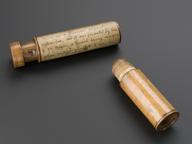

Hall haemoglobinometer, London, 1869-1930
- maker:
- Hawksley and Sons Limited




Hall haemoglobinometer by Hawksley and Sons Limited, 357 Oxford Street, London, England, 1869-1930; in case.
A haemoglobinometer measures the level of haemoglobin in the blood. Haemoglobin is a protein containing iron. Its primary responsibility is transporting oxygen from the lungs to other body tissues. It gives red blood cells their characteristic colour. The haemoglobin or iron content of the blood is used to estimate levels of malnutrition.
This example was made by London based instrument maker Hawksley and Son Limited. A sample of blood is taken to estimate the haemoglobin level. This is chemically treated and then compared to a colour index.
Details
- Category:
- Clinical Diagnosis
- Collection:
- Sir Henry Wellcome's Museum Collection
- Object Number:
- A600279
- Materials:
- complete, leather, plastic, silk, velvet, paper (fibre product) and brass (copper, zinc alloy)
- Measurements:
-
overall (case closed): 20 mm x 118 mm x 63 mm, 0.07 kg
overall (case open): 13 mm x 118 mm x 126 mm, 0.07 kg
- type:
- haemoglobinometer
- credit:
- Spriggs, N.I.




